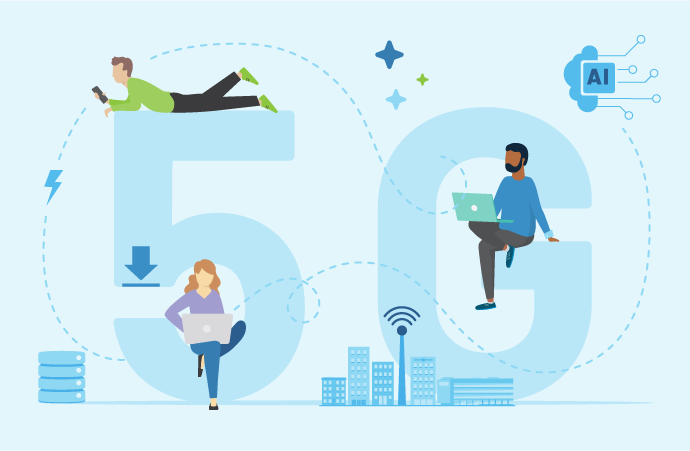5G technology is taking the world by storm: by the end of 2029, global 5G subscriptions are predicted to increase from 1.6 billion to 5.3 billion, with 5G coverage becoming available to 85% of the world’s population. For consumers, the latest generation of 5G smartphones are equipped with greater bandwidth, better connectivity, and higher streaming speeds than ever before.
As 5G connectivity increases, the technology is reshaping businesses and industries – driving a wave of transformation and the rapid growth of the digital economy.
Enhancing Connectivity: 5G’s Impact on Business Communication
5G delivers seamless connectivity via an ecosystem of technologies and sensors all linked with one another. The most immediate benefit is speed, delivering rapid transfer rates of over 1Gbps. The implementation of 5G technology increases network speeds and reduces lag time in communications – enhancing data sharing and facilitating collaboration both within and between organizations.
What’s more, bandwidth is significantly greater than previous networks, connecting up to a million devices per square kilometre. By enabling better internet access around the world, 5G has the potential to revolutionize remote working and accelerate the shift to global hiring – making it easy for businesses to work with contractors or employees in any location.
5G Technology’s Role in Driving Digital Transformation
The rollout of 5G wireless technology is transforming not only the way we work but all aspects of how we live – heralding the arrival of a new digital age in an increasingly interconnected world. The growth of 5G networks provides the infrastructure required to support the new wave of internet-connected products, with ultra-fast connections between servers and devices, unlimited internet rates, and radically-decreased latency compared with previous technologies.
These capabilities enable new feature-rich applications and services that rely on higher speeds and more stable connectivity for cloud computing, video streaming, and virtual reality. And, as more devices are connected, the widespread availability of 5G networks will further drive the advancement of emerging technologies such as automation and AI.
Securing Business Data in the 5G Era
While the possibilities of 5G are exciting, there are currently billions of IoT devices across the world – each one representing an access point for hackers. Many of these devices lack built-in security and may not require user authentication to function. Cybercriminals could also gain unauthorized access to systems and sensitive data via unpatched vulnerabilities in IoT devices.
That’s why it’s important for organizations and their employees to adopt cybersecurity best practices, including:
- Running regular risk assessments on all 5G technologies
- Creating strong passwords and changing them regularly
- Implementing multi-factor authentication
- Restricting user access to sensitive information
- Using a VPN on all devices
- Installing anti-malware software with a threat detection system
- Setting automatic updates to patch vulnerabilities on all devices and apps
The Economic Impact of 5G on Industries
The convergence of AI, cloud, and 5G is rapidly reshaping industry – powering innovation across sectors like manufacturing, agriculture, mining, energy, and transport. 5G-driven digital transformation is delivering economic benefits for business, as organizations can improve operational efficiency, leverage automation and robotics, deliver immersive customer experiences, collaborate more effectively, and make better business decisions. In fact, 5G alone is expected to add US$960 billion to the global GDP by 2030 – almost 1% of the total.
Some examples of 5G transformation across industries include:
- Manufacturing. The first fully 5G-connected appliance factory in China replaces complicated machine cabling with 5G sensors to enable automation and boost productivity.
- Mining. In smart coal mines, workers can operate boring machines and conveyor trucks remotely via wireless networks, improving workplace safety.
- Agriculture. 5G technology allows farmers to monitor soil moisture and fertilizer levels in real time, helping to maximize crop yields and reduce costs.
- Education. Teachers can analyze real-time data on student performance, and adapt their teaching methods to create personalized learning experiences.
5G Technology in Retail: Enhancing Customer Experience
5G opens up new opportunities for retailers to engage with their customers, delivering highly personalized shopping experiences. A 5G network can digitize bricks-and-mortar stores using facial recognition, AI, and augmented reality – creating a seamless customer journey that bridges the divide between online shopping and physical stores. It also enables retailers to gather large quantities of data on customer shopping habits and preferences, to customize their marketing and promotions to each person.
For example, screens placed in store-front windows could react to passersby in real-time, with tailored greetings to draw in customers. Leveraging artificial intelligence, mirrors in change rooms can become virtual shopping assistants – offering recommendations on style, fit, and size, based on the individual customer profile. With augmented reality (AR), customers could browse products on their 5G phone, even trying on clothing or visualizing a piece of furniture in their own home.
Reshaping Urban Landscapes: What Does a Smart City Look Like?
5G is redefining the way we plan and experience cities. The network connects all elements of urban infrastructure, from public transport to traffic lights, allowing them to communicate in real-time to optimize traffic flow and enhance public safety. Self-driving cars are quickly becoming a reality, communicating with other vehicles and smart city infrastructure to create a safer, more efficient transportation system. In a 5G-enabled smart city, energy consumption is monitored and controlled in real-time to respond dynamically to changes in demand. With a growing push for sustainability, 5G sensors and IoT devices throughout the city can collect accurate data on air quality and pollution levels to make informed environmental decisions. The integration of smart technology in public services creates a safer living environment – from faster emergency service response times to predictive policing and intelligent waste management. Healthcare services can be delivered remotely to people with access barriers through virtual consultations. Critical medical is data transmitted in real-time, contributing to better health outcomes and citizen wellbeing. |


